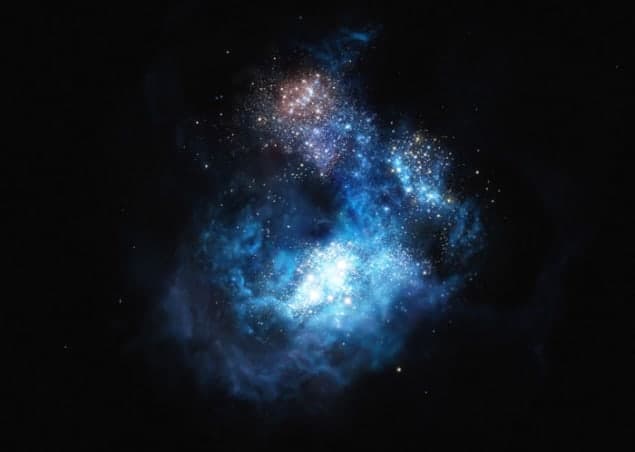
The first possible detection of the earliest stars formed in our universe has been made by an international team of researchers. Using ESO’s Very Large Telescope, the team discovered the brightest distant galaxy observed in the early universe, and in the process found evidence for the as-yet-undetected first generation of massive stars that lie within it. While there has been no conclusive physical proof of their existence until now, astronomers have been keen to study these early behemoths as they had a significant effect on the environment of the nascent universe.
Immediately after the Big Bang, the only chemical elements that existed were hydrogen, helium and some trace amounts of lithium. All heavier elements such as oxygen, nitrogen, carbon and iron – referred to as “metals” by astronomers – require the presence of stars to form. Some are forged in the high-pressure centres of stars, and the heaviest ones are created when the first, enormous stars exploded in supernovae.
Elusive population
The stars we currently observe in our universe fall into two categories: metal-rich “population I” stars such as our Sun, which contain large amounts of heavier elements, and older, metal-poor “population II” stars, such as those in the Milky Way’s halo, which contain less recycled material.
A population that has remained conspicuously absent, however, are the very first stars, which should have formed before the recycled materials existed. These hypothetical, extremely metal-poor stars, termed “population III” stars, should have started forming between 106 and 107 years after the Big Bang. Not only would these early stars have been extremely hot and enormous – several hundred or even a thousand times more massive than the Sun – they would have exploded as supernovae after only about two million years, seeding the universe with the metals to form population II stars. But while they have been theoretically predicted, they are yet to be directly detected, as spotting these stars is very difficult. They were extremely short-lived and would have shone at a time when the universe was largely opaque to their light, towards the end of the “dark ages”.
A team led by David Sobral at the University of Lisbon, and Leiden Observatory in the Netherlands, may have changed this paradigm with the recent detection of an extremely bright galaxy in the early universe. Indeed, as the team’s survey looks at exceedingly distant galaxies, it lets us look back in time, revealing the universe as it was a mere 800 million years after the Big Bang. The survey uncovered several unusually bright galaxies, including the brightest galaxy ever seen at this distance – an important discovery in itself.
But further scrutiny of this galaxy, named CR7, produced an even more exciting find – a bright pocket of the galaxy contained no sign of any metals, and further observations with other telescopes confirmed this initial detection. “By unveiling the nature of CR7 piece by piece, we understood that not only had we found by far the most luminous distant galaxy, but also started to realize that it had every single characteristic expected of population III stars,” says Sobral.
Formation waves
Sobral and his team postulate that we are observing this galaxy at just the right time to have caught a cluster of population III stars – the bright, metal-free region of the galaxy – at the end of a wave of early star formation. The observations of CR7 also suggest the presence of regular stars in clumps around the metal-free pocket. These older, surrounding clusters may have formed stars first, helping to ionise a local bubble in the galaxy and allowing us to now observe the light from CR7.
It was previously thought that population III stars might only be found in small, dim galaxies, making them impossible for us to detect. But CR7 provides an interesting alternative: this galaxy is bright, and the candidate population III stars are surrounded by clusters of normal stars. This suggests that these first-generation stars might in fact be easier to detect than was originally thought.
Additional observations with other telescopes will help to confirm the identity of these stars. In particular, NASA’s upcoming James Webb Space Telescope, set to launch in 2018, is expected to further advance the pursuit of the earliest galaxies and stars in the universe.
The work is to be published in the Astrophysical Journal. A preprint is available on arXiv.



